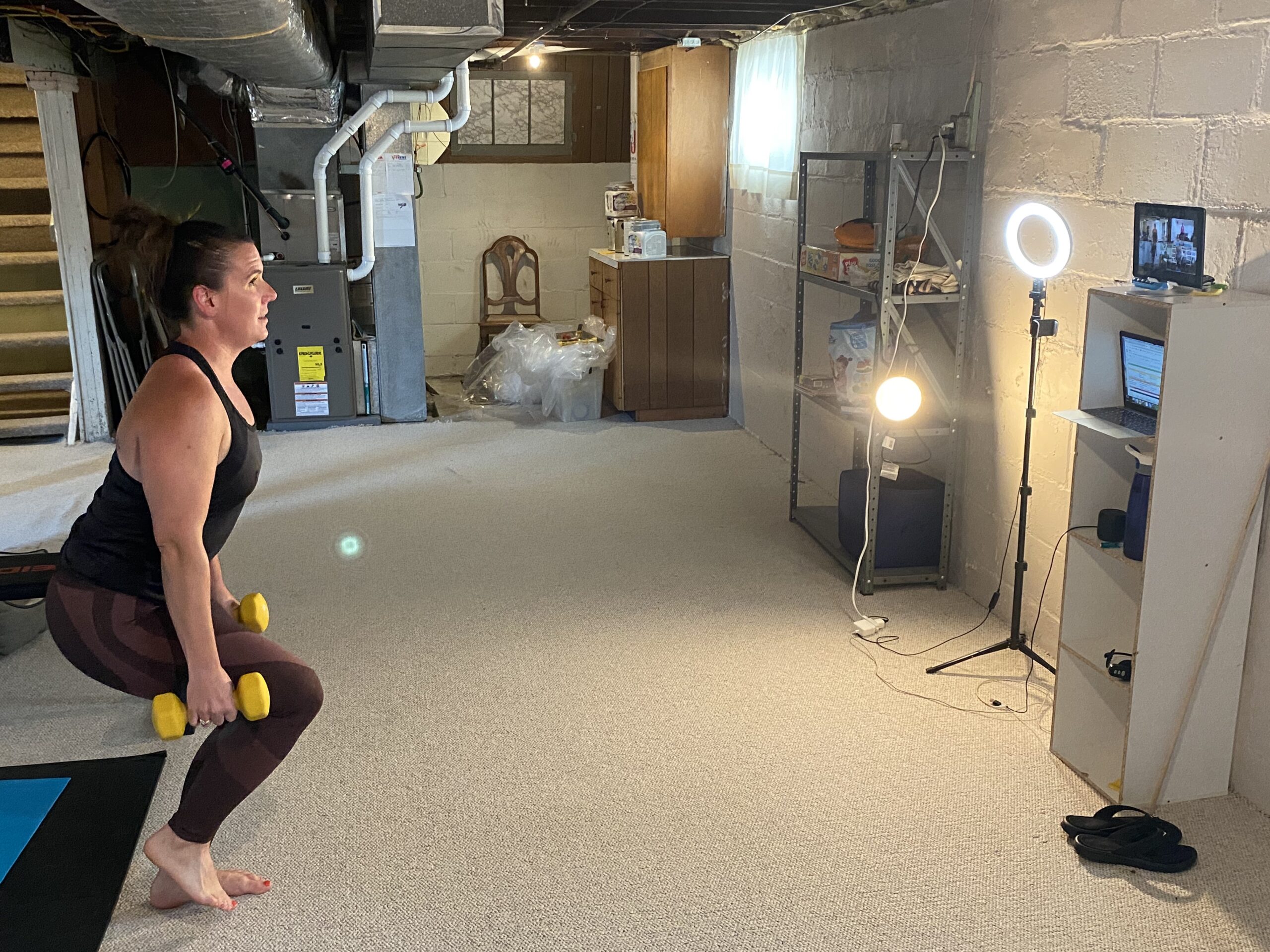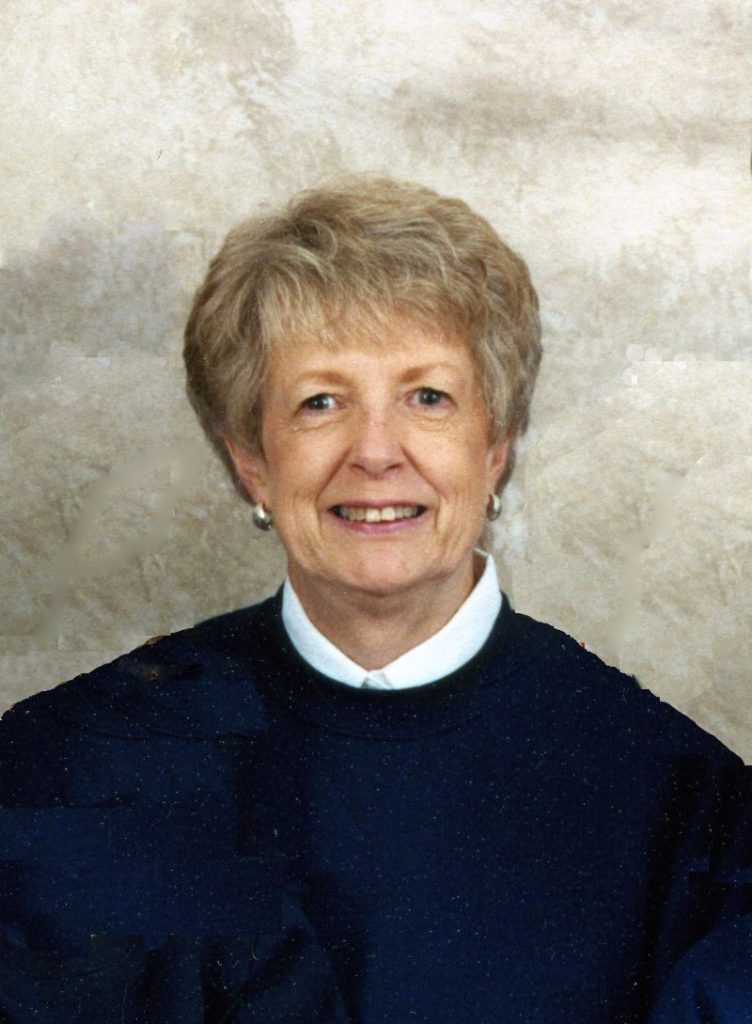Workouts from home, like work, gaining popularity; fitness facilities learning how to entice people to come back

QUINCY — Sam McKelvie greets the people in her class with “Hello, my friends,” then instructs them to begin stretching before they start exercising.
It’s a routine she’s gone through many times.
On some days, those instructions are given in a studio she rents in the Washington Theatre building in downtown Quincy. On many days, however, those same instructions are given to people participating in a Zoom meeting from their home while McKelvie works out in the basement of her Quincy home. One person was a project manager with a national company out of Cincinnati. Another was an attorney from Charlotte, N.C.
“My business has quadrupled since I started doing all of this online,” she said. “I put almost all of my energy into getting more clients online.”
The pandemic has reshaped how Americans exercise, and it has upended the fitness industry. It has accelerated the growth of a new era of high-tech home workout equipment and virtual classes.
Study: Roughly 9,000 health clubs have closed since virus outbreak
Roughly 9,000 health clubs — 22 percent of the total nationwide — have closed since the beginning of the virus outbreak and 1.5 million workers lost their jobs, according to the International Health Racquet & Sportsclub Association. Those still in business are redesigning their spaces, turning toward more personal workouts and adding online training as they deal with the onslaught from the exercise apps and pricey bikes and treadmills now available.
The Associated Press reported interactive fitness equipment maker Peloton recently broke ground on its first U.S. factory just outside Toledo, Ohio. It plans to begin production in 2023 and employ 2,000 workers. Demand during the pandemic was so high that some Peloton customers had to wait months for their bikes.
McKelvie, who grew up in Quincy and Mendon, worked for several years in social entrepreneurship in Brooklyn, N.Y. She quit her job in the spring of 2019 and became certified as a personal trainer. She now owns and operates her own business, ie Fitness.
“COVID hit in March (2020), and everything’s closed in New York,” she said. “So I was kind of forced into this.”
Clients from around the country join McKelvie for workouts
Many of her exercise clients are former clients from her previous job or members of the church she attended in Broolyn. However, since moving back to Quincy in 2021, McKelvie has picked up other clients from around the country.
“It’s just sort of knowing who your client base is,” she said. “I am looking to work with people and help people who are not trying to benchpress hundreds of pounds. They’re trying to bring exercise and nutrition into their lives consistently. They’re busy parents, they’re busy lawyers, they’re busy social workers. Some are older people who don’t want to schlep to the gym all the time, especially during COVID. It’s people from all different walks of life.
“The thing they all have in common is they’re looking for something consistently that isn’t super intrusive into the rest of their life. They can get a great workout that’s tailored for them more so than just an app. They know I’m there waiting for them, so they have to show up, right? Finding that consistency is what keeps my clients coming back.”
McKelvie says she works regularly with about 25 clients. All they typically need are an exercise band and/or hand weights.

Duerr: ‘People missed seeing their friends in fitness classes’
Angie Duerr is the membership services manager at the Kroc Center, 405 Vermont. She says the number of people using the facility has remained stable — down a little, but not much.
“We definitely saw a decrease when we shut down last year,” she said. “When we reopened and we had restrictions, we lost a substantial amount of members. As things started to improve, we had a nice little bump, and knock on wood, we’re within a very nice range now. It’s much more like when you look at the numbers. I don’t cry anymore.
“We’ve seen those people who have said, ‘I just bought my whole entire home gym, and now I’m good to go and I never want to leave the house.’ They’ve canceled their membership, and more power to them. We are just thankful they’re still working out.”
Duerr also says some people missed the camaraderie and fellowship of working with others in the gym.
“People missed seeing their friends in the fitness classes they attend to,” she said. “They’re saying, ‘I’ve made do working out at home, but I now want to see all my friends.’
“We’ve seen a mix of all kinds of things.”
Fitness clubs now offering virtual component to nearly all classes
Duerr said many Kroc clients enjoy working with pre-choreographed Les Mills on-demand programs, rather than doing classes on Zoom. All Kroc members are offered a discounted fee of $9.99 monthly to download the Les Mills app. Duerr said approximately 50 people signed up for the app.
“You still need equipment and different things like that, but you can make do like you can with any at-home workout,” she said.
Duerr says the pandemic has forced many fitness facilities to add a virtual component to nearly all of its classes. ClubIntel found 27 percent of the 2,000 people who participated in an online survey said their fitness clubs offered digital fitness during Covid closures, according to a story in the New York Times. That figure rose to 58 percent after clubs reopened.
“That really is going to be the trend of all fitness across the nation,” Duerr said. “This is me being a soothsayer, but within the next five years, if you go to a gym anywhere, there’s going to be a virtual component to every membership. We’re in the very beginning stages of researching these platforms, but not only are people being forced to do (offer virtual components), but they’re being forced to add them in at no extra charge. People are saying, ‘I’m not going to join your gym unless there’s a virtual component, and I’m not paying extra for it.’”
Loatsch: Over-age-65 crowd first to return
Cheryl Loatsch, who has operated her own fitness center and dance studio at 334 S. 48th since 1980, said she “had to scramble” to keep her clients active when the pandemic forced people inside their homes in March 2020.
“You had many people who were very confused about what they could or couldn’t do, what was good for them and what wasn’t,” she said. “They just felt like they had to stay home. We did online classes on video, like our yoga and our Pilates, things that they could follow and more than likely had space to do in their own home. The classes consisting of conditioning and weight training and any kind of cardio work, we tried to duplicate with by going outside or limited work inside.
“But a lot of people didn’t work out. A lot of people did nothing. That was probably the thing I struggled with the most.”
Loatsch said the over-age-65 crowd was the group to first return — or never left in the first place.
“They know how valuable (exercise) is to their quality of life,” she said. “We were approached by that age group, with different ones saying, ‘Are you going to lock the door? Will there be a way we can do something?’ If clients asked, we sent weights home. We sent notes home about what to do. We accommodated them in any possible way we could.”
Adults with families struggled to keep exercise part of their daily routine.
“If you had children home, and you had been working out during the day, the whole COVID thing jumbled up people’s schedules,” Loatsch said. “Once you get out of sync, once you’re off your schedule, it’s very difficult for you to get it back in there.”
McKelvie: ‘Having the flexibility is such a beautiful thing’
Loatsch checked in on her clients, “calling every person from A to Z” every three to four months.
“It was good, because it kept me current with what their situation was,” she said. “Did you have small children at home? Did you have a kid come home from college? Was their spouse working from home? Are the medical issues they had before getting worse?”
Once her clients started returning to her facility, she listened to what they said.
“I decided to let it evolve,” Loatsch said. “I became very comfortable with letting the membership drive the product, the process and the speed at which we returned to normal. The reason people come to a place like this in the first place is because they want to make sure they’re educated about doing what they need to do properly. They are need to be motivated by an instructor and guided by an instructor.”
Those instructors are being found more often on your computer screen.
“There have always been people working out at home. I was doing my mom’s Jane Fonda tapes as a kid,” McKelvie said. “I think people’s understanding of what’s possible from home, in fitness and their book clubs and their social lives, has expanded a lot. Having the flexibility is such a beautiful thing.”
Miss Clipping Out Stories to Save for Later?
Click the Purchase Story button below to order a print of this story. We will print it for you on matte photo paper to keep forever.

